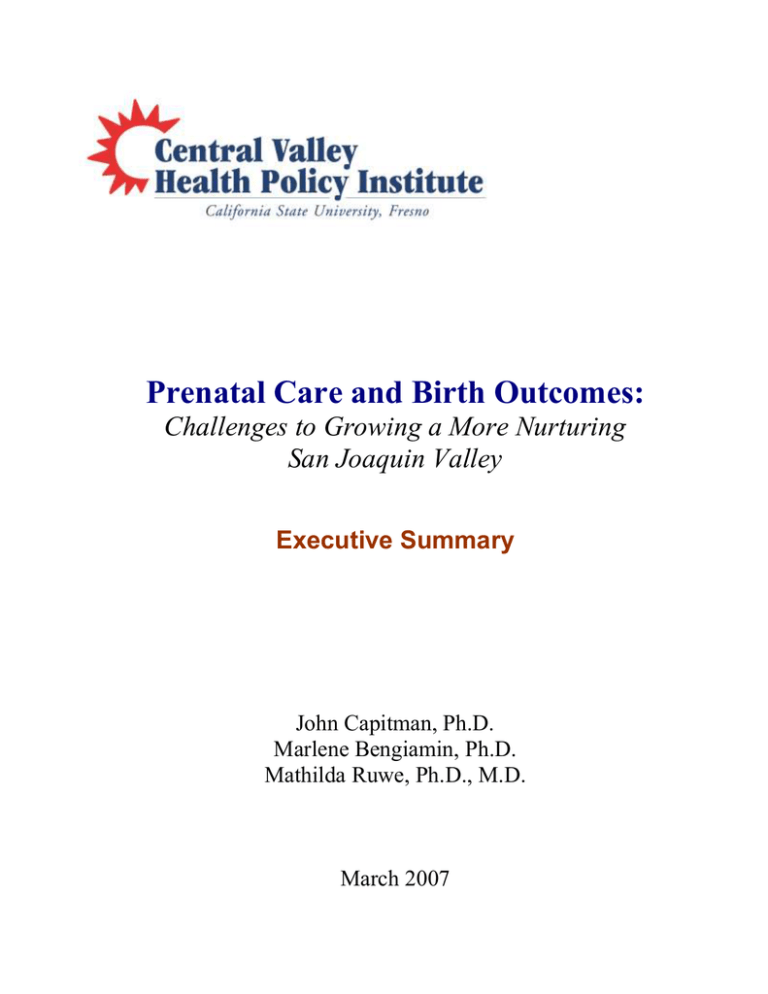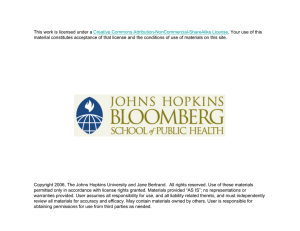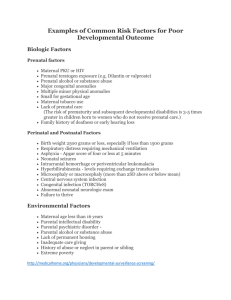Prenatal Care and Birth Outcomes: Challenges to Growing a More Nurturing
advertisement

Prenatal Care and Birth Outcomes: Challenges to Growing a More Nurturing San Joaquin Valley Executive Summary John Capitman, Ph.D. Marlene Bengiamin, Ph.D. Mathilda Ruwe, Ph.D., M.D. March 2007 THE CENTRAL VALLEY HEALTH POLICY INSTITUTE The Central Valley Health Policy Institute was established in 2002 at California State University, Fresno to facilitate regional research, leadership training and graduate education programs to address emerging health policy issues that influence the health status of people living in the San Joaquin Valley. The Institute was funded in July, 2003 by The California Endowment, in partnership with the University, to promote health policy and planning in the region. Additional information about the Central Valley Health Policy Institute, its programs and activities, a health related calendar, and academic and community resources may be found at www.cvhpi.org. This report was supported through a grant from The California Endowment to California State University, Fresno. The views expressed in this report are those of the authors and do not necessarily reflect those of the funders or the university. Central Valley Health Policy Institute Central California Center for Health and Human Services College of Health and Human Services California State University, Fresno 1625 E. Shaw Avenue, Suite 146 Fresno, CA 93710-8106 559.228.2150 Fax: 559.228.2168 Executive Summary The San Joaquin Valley faces important challenges in pre-natal care and birth outcomes. This monograph reports on the findings of three new studies addressing aspects of this challenge: A study of three-years of California birth records, 2002-2004, 2) a qualitative evaluation of system barriers in three of the region's counties and 3) a meta-analysis and systematic review of race and insurance-related disparities in prenatal care in California compared to other states, in the context of the 1990s Medicaid expansion. The three-year analysis of California birth records explored how demographic characteristics, insurance, and residential location influence adequacy of care and birth outcomes in the San Joaquin Valley. The qualitative study, conducted in three of the region’s counties, focused on provider experiences in serving pregnant and post-partum women. The systematic review and metaanalysis of published studies on the adequacy of prenatal care focuses on how the Medicaid expansions of the 1990’s influenced racial/ethnic prenatal care disparities in California compared to other states. In this summary we provide a brief report of key findings, conclusions and policy/program recommendation. A brief background section describes findings from other studies on adequacy of prenatal care. Detailed findings and discussions can be found in each of the full reports. I. Birth Patterns in the San Joaquin Valley: An Analysis of Inadequate Prenatal Care, Pre-term Births and Low Birth Weight - Key Findings Authors: Marlene Bengiamin, Ph.D., John Capitman, Ph.D., Mathilda Ruwe, Ph.D., M.D. The three-year prenatal birth outcomes study revealed significant demographic (race/ethnicity, age, education, etc.) and insurance status disparities in adequacy of prenatal care and highlights the important role of pre-natal care adequacy in birth outcomes. Also shown are dramatic differences in adequacy of prenatal care across communities in the Valley. During the period 2002 to 2004 one in 4 (about 23%) of pregnant women in the eight counties of the San Joaquin Valley (Fresno, Kern, Kings, Madera, Merced, San Joaquin, Stanislaus and Tulare) had inadequate prenatal care. There was no significant reduction over time in the percentage of women receiving inadequate prenatal care during the three-year period. Annual rates of inadequate prenatal care were: 25% in 2002 21% in 2003 23 % in 2004 Similarly, there was no significant reduction by race, over the three-year period, in the rate of inadequate prenatal care. There were significant associations, however, between a number of demographic factors and prenatal care adequacy, low birth weight and pre-term birth. Inequalities in adequate prenatal care and birth outcomes were apparent both between white women and women in underserved racial/ethnic groups and between women with private and public insurance. Specifically, Asian/Pacific Islander, African American, Hispanic and American Indian mothers; women who had less than 12 years of schooling; women who had Medi-Cal or other public insurance; and women younger than 20 years old were more likely to have inadequate prenatal care use. The role of race/ethnicity in prenatal care adequacy: Asian Pacific Islanders were 27% less likely to receive adequate care than Whites American Indians were 22.7% less likely to receive adequate care than Whites African American mothers were 19% less likely to receive adequate prenatal care than Whites Hispanic mothers were 17% less likely to receive adequate care than Whites The role of insurance coverage in prenatal care adequacy: Mothers on Medi-Cal were 46% less likely to receive adequate prenatal care than mothers who had private insurance. Mothers who had public insurance (other than Medi-Cal) were 25% less likely to receive adequate prenatal care than mothers who had private insurance. Mothers who self paid were 7.2% more likely to receive adequate prenatal care than mothers who had private insurance. Other social risk factors associated with prenatal care adequacy included: Mothers with less than a high school education were 26% less likely to receive adequate prenatal care than mothers who were more educated Mothers younger than 20 years of age were 31% less likely to have adequate prenatal care than older mothers Immigrant mothers (other than those born in Mexico) were 6% less likely to receive adequate prenatal care than US born mothers Mothers born in Mexico were 7.2% more likely to receive adequate prenatal care than US born mothers Place of residence, county or community cluster, also had an impact on adequacy of care. With the exception of Fresno County, variations in adequacy of care among the other counties were small. Merced, Kings and San Joaquin counties had the highest percentages of inadequate care in the Valley (39%, 43% and 50% respectively), while Fresno County had the lowest percentage of inadequate prenatal care in the region and one of the second lowest percentage in the State. There were, however dramatic differences by community clusters. We identified the five highest and lowest community clusters for each dependent variable (prenatal care adequacy, low birth weight and pre-term birth) before and after controlling for demographics. We noted very little change in the odds ratios after controlling for demographics. County and community cluster variations in inadequate care were largely independent of demographic factors. Read the full report… II. Adequate Prenatal Care: A Provider Perspective Authors: Marlene Bengiamin, Ph.D., John Capitman, Ph.D., Harinder Shahal, B.S., Tona Soto, M.P.H. The qualitative examination of system barriers in three San Joaquin counties Valley (Merced, San Joaquin and Stanislaus) suggests that public sector healthcare providers view a dire need for expanded community efforts and more resources to support pregnant women, while private sector providers are serving better insured, more educated, and more medically adherent clients and thus see little value in expanded public efforts to improve pre-natal care. Generally speaking, the data confirmed common assumptions regarding the different populations served by private and public clinics. On average, public providers had a higher percentage of Medi-Cal patients (86.9%) than private providers (43.0%), and public providers reported that an average of 3.2% of their patients had private insurance, as compared to private providers where 42.1% of their prenatal and post partum patients had private insurance. A number of systemic barriers to receipt of adequate prenatal and post-partum care were noted. Short-Staffing (including a shortage of physicians) resulted in delays in obtaining appointments and affected the types of insurance accepted at clinics. Staff Attitudes: Although not directly addressed by the survey, staff attitudes toward patients from different racial/ethnic backgrounds emerged as a salient issue when respondents were asked to assess their level of comfort in helping prenatal patients from different racial/ethnic backgrounds. This was most noted in the comments related to adherence, self responsibility and value/belief systems. Reimbursement: Responding pre-natal and post-partum provider organizations consistently noted the importance of reimbursement rates and payment timeliness from insurers as determinants of their capacity to meet the demands for care. There were noted differences in reimbursement rates between public and private insurance, as well as concerns regarding limitations on coverage and frequent denials of coverage from public payers. Language: Overall, 38.0% of all patients were viewed as needing interpreter services. Among all counties, Merced had the highest proportion (57.5%) of interpreter utilization, as compared to Stanislaus (32.2%) and San Joaquin (36.0%). In addition, more public provider patients (53.9%) required interpreter services, as compared to private provider patients (16.3%). Structural Barriers: Factors associated with poverty, such as a lack of viable transportation to clinics and a lack of child care for the patient’s other children, were noted by providers as common barriers to appropriate service. Outreach: Though nearly 90% of all sites agreed that outreach efforts would increase the number of women receiving adequate prenatal care, clinics reported not being able to offer as extensive a set of outreach services as they felt would be necessary to make a difference. Current financing and reimbursement did not support these services. Less than half of the private providers surveyed utilized some form of community outreach education while over 90% of public providers reported utilizing multiple outreach methods. Read the full report… III. Racial/Ethnic Disparities in Prenatal Care in California: How Much Does Insurance Matter? A Systematic Review and Meta-analysis – Authors: Mathilda Ruwe, Ph.D., M.D., John Capitman, Ph.D. Tonantzin Soto, M.P.H., Marlene Bengiamin, Ph.D. The systematic review and meta-analysis suggests that California was more successful in improving prenatal care access than other states, but that racial/ethnic disparities persisted. Notably, the study emphasizes a number of policy and programmatic components that seem to be associated with California’s achievement in this domain, while indicating that differences between the Valley and other portions of the state in the implementation of the Medicaid expansion may account for poorer outcomes in the region. We found compelling evidence on the impact of Medicaid expansion on reducing prenatal care inadequacy. Before Medicaid expansion, women of color when compared to white women, had 2.61 times higher odds of inadequate prenatal care, however, this was reduced to 1.92 times higher odds of inadequate care during the Medicaid expansion. Women who had Medicaid or were uninsured had about 4.5 times higher odds of inadequate pre-natal care before the period of Medicaid expansion and 3.6 times during the period of Medicaid expansion. Nonetheless, there was great variation among states not only in reducing inadequate prenatal care, but also in the extent of the expansion and in how states optimized federal policies to extend coverage and care to pregnant women from underserved communities. California achieved the largest reduction in prenatal inadequacy for four out of five racial ethnic groups studied.(-17.5% for whites, -23.7% for blacks, -25.19 for Hispanic, 1.9 for Asian/American Indians for California; when compared to 2.7% for white, -2.4 for black, for 2.7 for Hispanic, and -3.35 for Asian/American Indian in other states). California's success is attributed to the fact that California launched one of the most inclusive Medicaid expansions and put in measures to remove barriers to enrollment, and utilization. However, racial/ethnic, insurance-related and regional disparities have persisted in California. Although the state programs and policies implemented during the period of major Medicaid expansion could also have worked for the San Joaquin Valley, the region appears to have unique challenges. Factors that influence racial/ethnic disparities in California as a whole may be largely the same factors that determine outcomes for the San Joaquin Valley as a whole and for sub-regions within the Valley o Except for Fresno, the sub-regions in the Central Valley implemented public health department enhanced programming and the comprehensive prenatal care service program later than coastal or urban areas in California. o Implementation of Medicaid managed care was also slower in the Valley and the use of a “two-plan” approach had less dramatic impact on the range of providers or the incentives to providers when compared to Medi-Cal managed care plans in other regions. Because of the region’s demography and service systems, a higher proportion of Medi-Cal births remained in fee-for-service plans than in other areas of California. o The capacity to generate state and local revenue to extend care to immigrants and others that did not qualify for Medicaid benefits varied by county. Read the full report… IV. Conclusions and Recommendations We concluded that the persisting racial/ethnic, insurance status and residential disparities in pre-natal care access and perinatal outcomes are part of the larger challenge of inadequate supply and maldistribution of healthcare resources in the Valley compared to other parts of California. At the same time, the persistence of residential place differences in pre-natal care access and birth outcomes, even after statistically controlling for demographic factors, point to within region variations in other social and economic conditions or quality of life factors that contribute to these disparities. Due to the unique demography in the region and the extent of disparities documented in this report, it seems likely that the region can not meet the Health People 2010 objectives or achieve parity with California without specifically addressing racial/ethnic and insurance status disparities in prenatal care and outcomes. There are important gaps in the research reported here. Most notably, this report does not reflect the perspectives of women in diverse communities across the region. More research is needed on both how women experience barriers to care and other factors that may influence their quality of life and birth outcomes. Research is also needed on how some women are able to beat negative odds in their communities and have positive birth experiences. A second major gap focuses on the differences among the Valley counties in prenatal access and birth outcomes. Although the report identifies a number of policy and program factors that may be associated with county differences in prenatal care access (Medi-Cal managed care penetration, private sector participation in CPSP, FQHC service availability relative to population, public health department outreach to high-risk mothers etc.) more work is needed on identifying how these factors interact with demography in shaping patterns of prenatal care access and quality. The research included in this report does not point to some new policy or program approach, but rather to the importance of more assertively implementing proven strategies. Two primary recommendations emerge from our work. First, and perhaps most importantly, given the region’s unique demographic challenges and other barriers to healthcare access and the success of prior work in this area, intensified efforts to support community education and individualized outreach to pregnant and post-partum women is needed. Ideally, individualized outreach and patient education programs need to be expanded through multiple channels, including health department programming for high risk mothers, community health center outreach programming, and the development of new financing streams to permit private sector providers to offer individualized outreach and education programs similar to those in the public sector. These programs need to have a specific focus on engaging pregnant women in early and regular care through carefully addressing cultural and individual differences in understanding and motivation to use services. Addressing concrete barriers to specific service use, such as transportation and childcare, need to be accompanied by helping pregnant women make important social and economic improvements in their lives to overcome place-related factors in perinatal outcomes. Second, a variety of efforts are needed to improve care access and continuity for women who are either enrolled in Medi-Cal or are eligible for Medi-Cal or other public coverage. Further expansion of MediCal managed care may be one element of this strategy, but many women who become eligible for MediCal or other public insurance because of their pregnancy are most often seen through fee-for-service. Thus, to improve access overall and reduce racial/ethnic and insurance disparities, programmatic efforts are needed to make public coverage more supportive. Program reforms can seek to facilitate easier and more rapid enrollment for pregnant women in Medi-Cal or other public coverage; improve Medi-Cal provider enrollment, improve reimbursement rates and reimbursement processing for prenatal and post partum service claims, and expand efforts to engage private sector providers in the Medi-Cal program (through incentive payments or case-mix requirements). This publication was funded by a grant from The California Endowment





